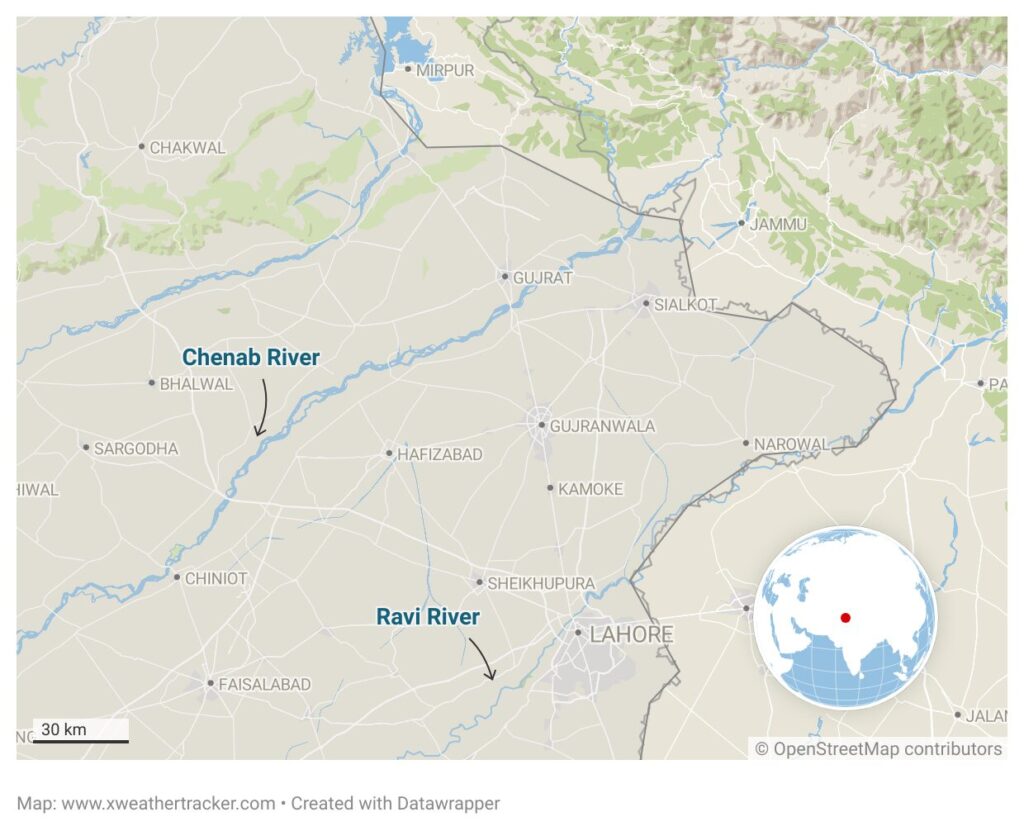Pakistan’s eastern Punjab province is grappling with its worst-ever flood, with river water levels reaching unprecedented highs.
Flooding is a regular occurrence during Pakistan’s monsoon season, typically spanning July to September. However, this year’s monsoon, intensified by the climate crisis, has brought unpredictable and deadly rains, causing widespread chaos and leaving the government struggling to respond. The mounting death toll as a result of flooding across the country has been reported regularly with now 849 the latest figure provided.
In Punjab more than 1,400 villages have been flooded after three large rivers – the Sutlej, Chenab and Ravi overflowed their banks because of heavy rain and the release of water from overfilled dams in neighbouring India.

The monsoon rains in 2025 have been significantly heavier, with Punjab receiving 26.5% more rainfall between 1 July and 27 August compared to the previous year. The city of Sialkot in 24 hours – 26/27 August saw record rainfall figures of 363.5 mm, the highest rainfall for the city in such a period of time since 1976.
The Indian authorities made contact with their counterparts in Pakistan over a week ago to warn of cross-border flooding as a result of India’s release of water from dams, including the Thein and Madhopur barrages. The matter has also been made worse with the collapse of flood gates at the latter barrage.
Pakistani officials, including Planning Minister Ahsan Iqbal, attributed the severity of the flooding to India’s failure to share timely water flow data after suspending the Indus Water’s Treaty in April 2025. Only three flood alerts were shared since 23 August covering the Tawi and Sutlej rivers but not the Ravi. The collapse of Madhopur floodgates was cited as a key factor in worsening downstream flooding particularly in the Lahore area. Experts and officials cited delays in opening the floodgates as a key factor. The gates were opened only after significant water releases from the Ranjit Sagar Dam, leading to immense pressure that caused the collapse. The Indian press at the same time have indicated that the warnings that were provided were instrumental in saving large numbers of the population.
It is now being reported that up to 1.4 million people have been displaced across the province. The Pakistan Army has been deployed in eight districts to assist with rescue operations, using boats and helicopters to evacuate residents and livestock. Critical infrastructure has been severely damaged with the rising waters bringing fears of disease. The province’s chief minister, Maryam Nawaz Sharif, declaring an emergency in hospitals across Punjab over fears that cholera and hepatitis could spread and an increased risk of poisoning from snake bites. It is feared that least 33 people have died in Punjab as a result of the flooding.
In addition to the government led relief efforts, voluntary and community-funded aid deliveries have been mobilised. In Sialkot volunteers from the charity Sherzan have been delivering cooked food, cartons of milk and water from the back of a truck pulled by a tractor which has been able to access some of the flooded areas.
Given Punjab’s role as Pakistan’s agricultural heartland, the latest flooding will have a profound impact on agriculture and subsequently food prices. The floods have destroyed or damaged key Kharif crops, (a crop sown at the onset of the monsoon) including wheat, rice, cotton, maize, and sugarcane, across Punjab’s fertile plains. Punjab produces over 75% of Pakistan’s wheat, 60% of its rice, and significant portions of cotton and sugarcane, making these losses critical.
It is thought that thousands of livestock, including cattle, goats, and poultry, perished or were displaced due to flooding. The Punjab government distributed cattle feed as part of relief efforts, but the scale of the potential loss remains substantial.
Reuters reporting in the Chiniot District highlighted the plight of one farmer. Muhammad Amjad, 45, a rice and potato farmer standing by his submerged fields commented: “Thirteen of my 15 acres are gone. Our rice is completely destroyed. Women and children have evacuated. Men are left guarding what remains.”
🌧️ Punjab Floods 2025 (Update – Aug 30)
— Harsimranjit Singh Kler (@HarsimranKler) August 30, 2025
👥 7,689+ people evacuated
🏘️ 836+ villages affected
🌾 1.1 lakh acres crops damaged
🏫 300 schools impacted
🚨 Relief camps , food, water, fodder & medicines being distributed by punjabi. RT#PunjabFloods #FloodRelief #PunjabFloods2025 pic.twitter.com/w6P6DW7iUt
The impact on food prices has been significant with immediate price surges. Reports indicate a 20–30% increase in flour prices in Punjab’s urban markets like Lahore and Faisalabad. Damage to rice crops has driven up prices of basmati and other varieties, with wholesale prices increasing by 15–25%. While vegetable crops and fruits are already showing a 30-40% increase in local markets.
This latest major flood event is once again a stark reminder of how Pakistan is one of the most vulnerable countries in the world to the climate crisis, despite the fact that the country produces less than 0.1% of global greenhouse gas emissions.